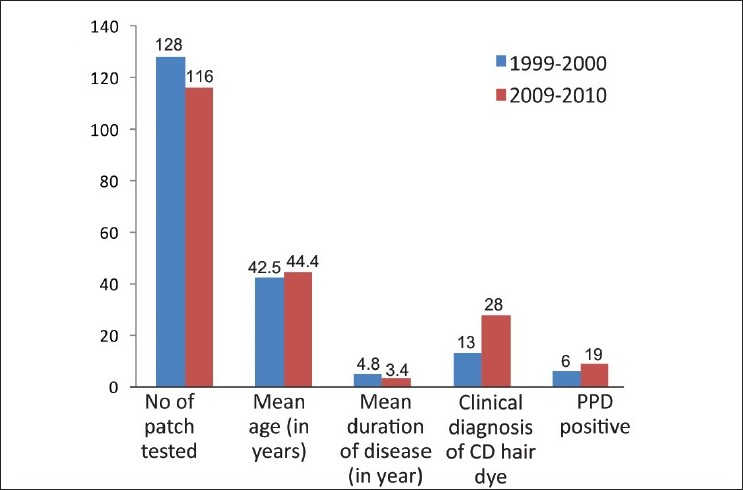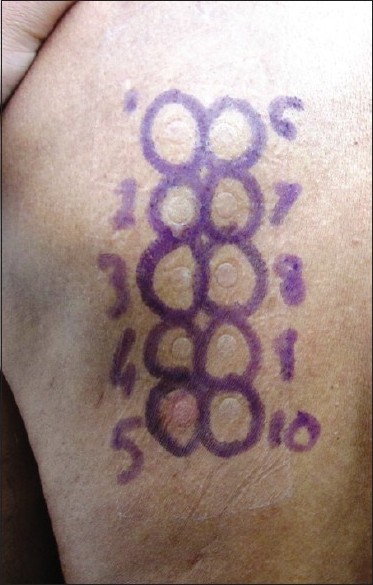Translate this page into:
Epidemiological trends in contact dermatitis to hair dye: Comparing para-phenylenediamine positivity after a decade long interval
Correspondence Address:
Sanjeev Handa
Department of Dermatology, Venereology, and Leprology, Postgraduate Institute of Medical Education and Research, Chandigarh
India
| How to cite this article: Handa S, De D, Mahajan R. Epidemiological trends in contact dermatitis to hair dye: Comparing para-phenylenediamine positivity after a decade long interval. Indian J Dermatol Venereol Leprol 2011;77:511-512 |
Sir ,
Hair dyes are a common cause of allergic contact dermatitis among cosmetics. The most important ingredient in permanent hair dyes is para-phenylenediamine (PPD). After its introduction in 1880s, PPD was banned from France and Germany in 1906 because of its allergenic potential, but was reintroduced in 1990′s. Oxidation of PPD produces benzoquinone, P-aminophenol, and N-phenyl-PPD which are potent sensitizers. Additives, such as pyrogallol and resorcinol, are other potential allergens. Sharma et al.[1] reported a frequency of PPD positivity to be 11.5% among patients of contact dermatitis from India. [1] The present study was undertaken to compare the prevalence of allergic contact dermatitis to hair dyes now and a decade before.
In this retrospective study, case records of patients attending the Contact Dermatitis Clinic of our institute over a 1-year period a decade ago (1999-2000) and now (2009-2010) were compared. Patients with a positive patch test reaction to PPD and established relevance were confirmed to have developed allergic contact dermatitis secondary to hair dye exposure and were included in the final analysis. The patients were patch tested with the Indian standard series (ISS) (Systopic Laboratories Ltd., New Delhi, India) using Finn Chambers® , mounted on micropore. The tested allergens included PPD 1% in petrolatum. Patients′ hair dye was also used for patch testing ′′as is.′′ All allergens were applied on the upper back and removed after 48 h. The sites were examined at 48 h and 96 h and graded according to the International Contact Dermatitis Research Group guidelines.
A total of 128 patients had been patch tested during the period 1999-2000 and 116 patients during the period 2009-2010 [Figure - 1]. Thirteen out of 128 and 28/116 were clinically suspected to have allergic contact dermatitis to hair dye. The mean age of study cohort was 42.5 years (31-54 years) with a male to female ratio of 1.1:1 during the former period compared to mean age of 44.4 years (34-56 years) and a male to female ratio of 1.4:1 during the latter period. During the 1999-2000 period, the patch test positivity to PPD with established relevance was seen in six patients. Thus prevalence of allergic contact dermatitis to hair dye among patch-tested patients was 4.7%. One plus reaction was seen in five patients and 2+ reaction in one, while no patient had a 3+ positive reaction. During the 2009-2010 period, the patch test positivity to PPD was seen in 19 patients, thus giving a prevalence of 16.4%. One plus reaction was seen in 12 patients, 2+ in 4 and 3+ in 3 patients [Figure - 2]. The results represented roughly a fourfold rise in prevalence in a decade′s interval (P=0.007).
 |
| Figure 1: Baseline characteristics and number of patients showing PPD positivity on patch testing during the years 1999-2000 and 2009-2010 |
 |
| Figure 2: Patch-test result showing 2+ reaction to PPD in chamber number 5 at day 4 |
Approximately 40% of women in some geographical areas use hair-coloring agents. The prevalence of PPD sensitivity in various population based epidemiological studies has been estimated to be between 0.1% and 1%. [2] Penchalaiah et al.[3] studied the sensitizers commonly causing contact dermatitis from cosmetics in India. [3] Of 436 patients, 31 (7.1%) were suspected of having cosmetic dermatitis due to hair dye and only 8 (1.8%) showed positivity to 1% PPD.
In our study, the mean age of patients who presented with contact dermatitis to hair dye was 44.4 years during the years 2009-2010, which was similar to what it was a decade earlier. Dogra et al. [4] reported the age of presentation in cases of contact dermatitis to cosmetics to be slightly earlier in the second to third decade of life. [4] The gender ratio remained unchanged in our study with an insignificant male preponderance during both the study periods. The most striking finding in the present study was the significant increase in patients who were confirmed to have allergic contact dermatitis to hair dye, i.e.; clinical suspicion supported by positive patch test (4.7% vs. 16.4%). This is supported by the fact that there has been a significant increase in reactions to hair dyes in clients exposed to hair cosmetics between 1995 and 2006. [5] This might reflect the trend of ever increasing use of cosmetics by modern society, including hair dyes and PPD based tattoos; and thus a proportionate rise in the incidence of cosmetic dermatitis. In addition, it may also reflect sensitization to PPD by cross-sensitization with leather, fur, textile, and industrial rubber products. We conclude that there has been a significant increase in the prevalence of contact dermatitis to hair dyes in the last decade.
| 1. |
Sharma V K, Chakrabarti A. Common contact sensitizers in Chandigarh, India. Contact Dermatitis 1998;38:127-31.
[Google Scholar]
|
| 2. |
Schäfer T, Böhler E, Ruhdorfer, Weigl L, Wessner D, Filipiak B, et al. Epidemiology of contact allergy in adults. Allergy 2001;56:1192-6.
[Google Scholar]
|
| 3. |
Penchalaiah K, Handa S, Lakshmi SB, Sharma VK, Kumar B. Sensitizers commonly causing allergic contact dermatitis from cosmetics. Contact Dermatitis 2000;43:311-3.
[Google Scholar]
|
| 4. |
Dogra A, Minocha YC, Sood VK, Dewan SP. Contact dermatitis due to cosmetics and their ingredients. Indian J Dermatol Venereol Leprol 1994;60:72-5.
[Google Scholar]
|
| 5. |
Uter W, Lessmann H, Geier J, Schnuch A. Contact allergy to ingredients of hair cosmetics in female hairdressers and clients-an 8-year analysis of IVDK data. Contact Dermatitis 2003;49:236-40.
[Google Scholar]
|
Fulltext Views
3,030
PDF downloads
1,879





